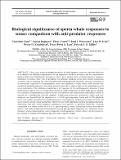Files in this item
Biological significance of sperm whale responses to sonar: comparison with anti-predator responses
Item metadata
| dc.contributor.author | Curé, Charlotte | |
| dc.contributor.author | Isojunno, Saana | |
| dc.contributor.author | Visser, Fleur | |
| dc.contributor.author | Wensveen, Paul J. | |
| dc.contributor.author | Sivle, Lise D. | |
| dc.contributor.author | Kvadsheim, Petter H. | |
| dc.contributor.author | Lam, Frans-Peter A. | |
| dc.contributor.author | Miller, Patrick | |
| dc.date.accessioned | 2016-11-03T16:30:12Z | |
| dc.date.available | 2016-11-03T16:30:12Z | |
| dc.date.issued | 2016-10-06 | |
| dc.identifier | 247346327 | |
| dc.identifier | f0ec50ec-e135-4f06-bb83-209eef5c209c | |
| dc.identifier | 85053361278 | |
| dc.identifier | 000387130800008 | |
| dc.identifier.citation | Curé , C , Isojunno , S , Visser , F , Wensveen , P J , Sivle , L D , Kvadsheim , P H , Lam , F-P A & Miller , P 2016 , ' Biological significance of sperm whale responses to sonar: comparison with anti-predator responses ' , Endangered Species Research , vol. 31 , pp. 89-102 . https://doi.org/10.3354/esr00748 | en |
| dc.identifier.issn | 1863-5407 | |
| dc.identifier.other | ORCID: /0000-0002-2212-2135/work/37031851 | |
| dc.identifier.uri | https://hdl.handle.net/10023/9758 | |
| dc.description | Research funding was provided by the US Office of Naval Research and the Ministries of Defence of Norway, the Netherlands and France as well as the UK Natural Environmental Research Council. | en |
| dc.description.abstract | A key issue when investigating effects of anthropogenic noise on cetacean behavior is to identify the biological significance of the responses. Predator presence can be considered a natural high-level disturbance stimulus to which prey animals have evolved adaptive response strategies to reduce their risk of predation by altering behavior away from fitness-enhancing activities such as foraging. By contrasting the type and magnitude (duration, severity, consistency) of behavioral responses to anthropogenic noise and playback of killer whale (KW) sounds that simulated predator presence, this study aimed to provide a relative index of the disturbance level as an indication of the biological significance of responses to the anthropogenic stimulus. Using multi-sensor tags as well as visual observations of surface behavior of adult male sperm whales, we assessed a comprehensive range of behavioral metrics that could reduce individuals’ fitness if altered for a biologically relevant duration. Combining previously published results and new analyses, we showed that the responses to 1-2 kHz upsweep naval sonar and to KW playback were very similar, including horizontal avoidance, interruption of foraging or resting activities and an increase in social sound production. However, only KW playbacks elicited grouping behaviors, indicating that this social response component was specific to predator detection. Animals responded to a lesser extent to 6-7 kHz upsweep naval sonar, indicating weaker disturbance effects. Our study demonstrates the benefit of using anti-predator responses as a reference of disturbance when evaluating the relative impacts of anthropogenic stimuli, which can be of particular interest in studies of threatened species such as sperm whales. | |
| dc.format.extent | 14 | |
| dc.format.extent | 315210 | |
| dc.language.iso | eng | |
| dc.relation.ispartof | Endangered Species Research | en |
| dc.subject | Sperm whales | en |
| dc.subject | Behavioral responses | en |
| dc.subject | Naval sonar | en |
| dc.subject | Anti-predator responses | en |
| dc.subject | Anthropogenic disturbance | en |
| dc.subject | QH301 Biology | en |
| dc.subject.lcc | QH301 | en |
| dc.title | Biological significance of sperm whale responses to sonar: comparison with anti-predator responses | en |
| dc.type | Journal article | en |
| dc.contributor.institution | University of St Andrews. School of Biology | en |
| dc.contributor.institution | University of St Andrews. Sea Mammal Research Unit | en |
| dc.contributor.institution | University of St Andrews. Marine Alliance for Science & Technology Scotland | en |
| dc.contributor.institution | University of St Andrews. Scottish Oceans Institute | en |
| dc.contributor.institution | University of St Andrews. Institute of Behavioural and Neural Sciences | en |
| dc.contributor.institution | University of St Andrews. Centre for Social Learning & Cognitive Evolution | en |
| dc.contributor.institution | University of St Andrews. Bioacoustics group | en |
| dc.contributor.institution | University of St Andrews. Centre for Research into Ecological & Environmental Modelling | en |
| dc.identifier.doi | 10.3354/esr00748 | |
| dc.description.status | Peer reviewed | en |
This item appears in the following Collection(s)
Items in the St Andrews Research Repository are protected by copyright, with all rights reserved, unless otherwise indicated.

